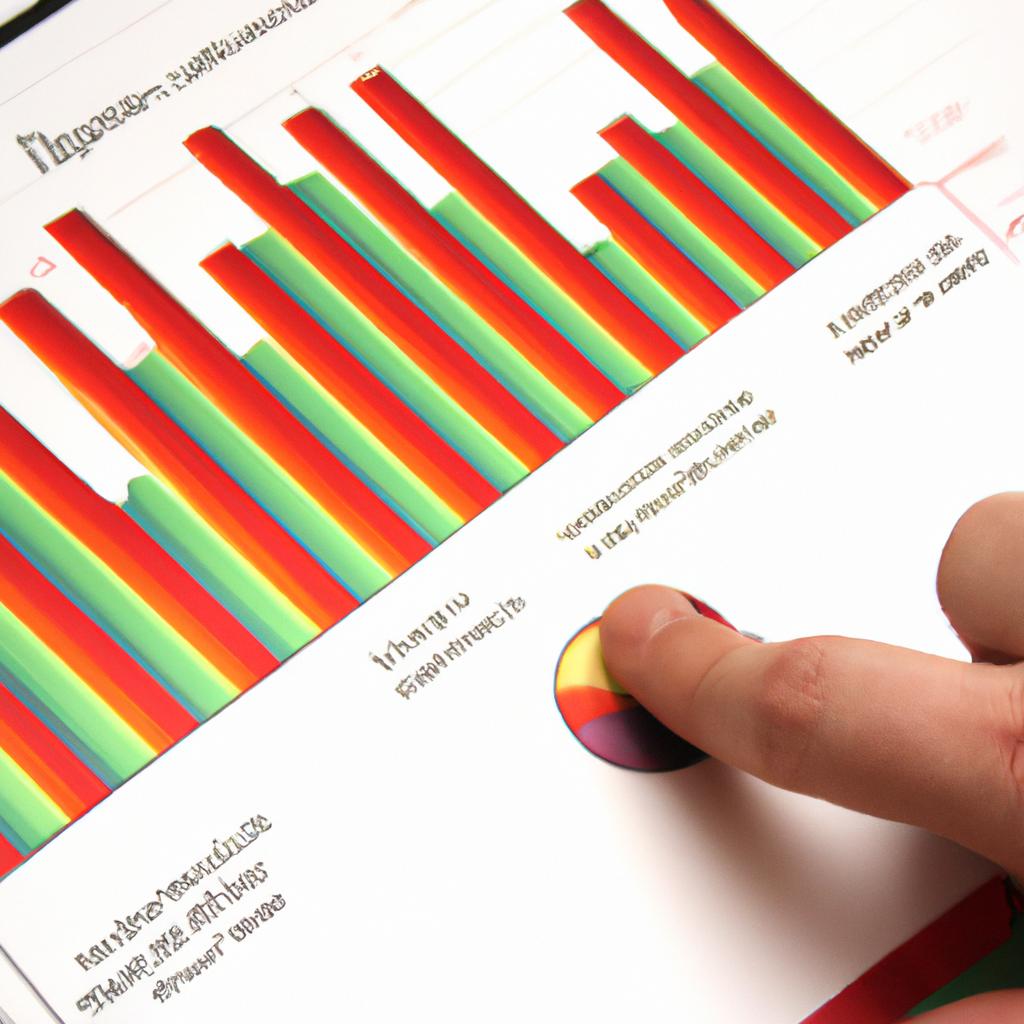A/B Testing for Email Campaigns: Enhancing Online Marketing & Advertising in Email Marketing

In the realm of online marketing and advertising, email campaigns have emerged as a powerful tool for businesses to engage with their target audience. However, in an era marked by information overload and diminishing attention spans, it has become crucial for marketers to optimize the effectiveness of their email campaigns. A/B testing, also known as split testing, offers a systematic approach to enhancing email marketing strategies by allowing marketers to compare two or more variations of an email campaign and determine which one yields better results.
For instance, consider a hypothetical scenario where an e-commerce company wishes to increase its click-through rates (CTR) for its promotional emails. By conducting an A/B test, the company can create two versions of the same email—one with a vibrant visual design and another with a minimalist layout—and send them out to separate segments of their subscriber list. The performance metrics such as CTRs from each version can then be compared to identify which design resonates better with the target audience. This example showcases how A/B testing provides invaluable insights into consumer preferences and enables businesses to make data-driven decisions when designing their email campaigns.
By leveraging A/B testing methodologies in email marketing campaigns, businesses can go beyond mere guesswork and apply a scientific approach towards optimizing their online marketing efforts. In this article , we will explore the key benefits and steps involved in conducting effective A/B tests for email marketing campaigns.
One of the primary advantages of A/B testing is its ability to provide quantitative data on user behavior and preferences. By comparing different variables such as subject lines, call-to-action buttons, visuals, or even the time of day the emails are sent, businesses can gain valuable insights into what resonates best with their audience. This data-driven approach allows marketers to make informed decisions about which elements to prioritize in future campaigns.
To conduct an effective A/B test for an email campaign, follow these steps:
-
Define your objective: Clearly establish what you want to achieve through your test. Whether it’s improving open rates, click-through rates, conversion rates, or any other metric, having a specific goal will help guide your testing process.
-
Identify variables: Determine which elements of your email campaign you want to test. This could include subject lines, sender names, email copy variations, imagery choices, layout designs, or any other relevant factors that may impact performance.
-
Split your audience: Divide your subscriber list into two (or more) groups randomly. Ensure that each group represents a statistically significant sample size to draw valid conclusions from the results.
-
Create variations: Develop multiple versions of your email by changing only one variable at a time. For example, if you’re testing subject lines, keep all other aspects of the email consistent across versions.
-
Test and measure: Send out each version to its respective segment and track key metrics using analytics tools or email service provider platforms. Monitor metrics such as open rates, click-through rates, conversions, bounce rates, or any other relevant indicators depending on your objectives.
-
Analyze results: Compare the performance metrics between the different versions of your email campaign. Identify patterns and determine which variation produced better results based on your predefined objective.
-
Draw conclusions and implement changes: Based on the results of your A/B test, make data-driven decisions about which elements to optimize or iterate upon in future campaigns. Implement the changes identified as more effective and continue testing to further refine your email marketing strategies.
-
Iterate and repeat: A/B testing should be an ongoing process rather than a one-time exercise. As consumer preferences and market dynamics evolve, continue experimenting with new variables and refining your email campaigns to stay relevant and maximize results.
By embracing the power of A/B testing in email marketing, businesses can gain valuable insights into their subscriber base, improve engagement rates, increase conversions, and ultimately achieve better ROI from their email campaigns.
Benefits of A/B testing in email campaigns
Benefits of A/B Testing in Email Campaigns
A/B testing, also known as split testing, is a widely used method in the field of email marketing to measure and enhance the effectiveness of campaigns. By comparing two or more variations of an email, marketers can gain insights into which elements are resonating with their audience and make data-driven decisions for future optimization. This section will explore the benefits that A/B testing brings to email campaigns, highlighting its ability to improve open rates, click-through rates (CTR), conversion rates, and customer engagement.
Enhanced Open Rates:
One significant benefit of A/B testing in email campaigns is its potential to increase open rates. For instance, imagine an online clothing retailer wanting to send out a promotional campaign for their new summer collection. They decide to test different subject lines: one using urgency keywords such as “Limited Time Offer,” while the other focuses on personalization by including the recipient’s name. Through A/B testing, they discover that personalized subject lines result in higher open rates compared to urgent ones. This valuable insight enables them to tailor future campaigns accordingly and maximize their reach.
Improved Click-Through Rates (CTR):
Another advantage of implementing A/B testing is its impact on click-through rates. Marketers often face challenges when deciding on various design elements within an email template, such as call-to-action buttons or placement of product images. By conducting A/B tests where these elements are altered between versions (e.g., button color or position), companies can identify what drives higher CTRs among their target audience. The emotional appeal created through visually appealing designs paired with persuasive copy may significantly influence user behavior and encourage more clicks.
Increased Conversion Rates:
Conversion rate optimization is crucial for any successful marketing strategy. With A/B testing, marketers have the opportunity to experiment with different content formats and layouts within emails—such as short versus long descriptions or single-column versus multi-column designs—to determine which approach leads to higher conversion rates. For instance, a travel agency may test two versions of an email promoting vacation packages: one featuring concise bullet points outlining key benefits and another with descriptive paragraphs highlighting specific itineraries. Through A/B testing, they can identify which format resonates better with their audience and subsequently increase the likelihood of conversions.
Enhanced Customer Engagement:
Lastly, A/B testing in email campaigns contributes to improved customer engagement. By segmenting their subscriber list based on demographics or purchase history and tailoring content accordingly, marketers can personalize emails for different groups. This personalization can range from including personalized recommendations based on previous purchases to using dynamic content that adapts to each recipient’s preferences. Such customization fosters a sense of connection between customers and brands, leading to increased engagement levels and ultimately driving repeat business.
In summary, A/B testing provides several significant benefits when implemented in email marketing campaigns. From increasing open rates through engaging subject lines to improving click-through rates by optimizing design elements within email templates, this method allows marketers to make informed decisions driven by data rather than assumptions or guesswork. Moreover, by experimenting with various content formats and layouts, companies can enhance conversion rates while simultaneously enhancing customer engagement through personalized communication strategies.
Transition Sentence into the Next Section:
To maximize the effectiveness of A/B testing in email campaigns, understanding how to choose the right variables for experimentation is crucial…
Choosing the right variables to test
Enhancing the Effectiveness of Email Marketing through A/B Testing
Email marketing has proven to be a powerful tool for businesses to engage with their target audience and drive conversions. However, not all email campaigns yield the desired results. This is where A/B testing comes into play, allowing marketers to fine-tune their strategies and optimize campaign performance. In this section, we will discuss the importance of choosing the right variables to test in order to enhance online marketing and advertising in email campaigns.
To illustrate the benefits of A/B testing, let’s consider a hypothetical scenario where an e-commerce company wants to improve its click-through rate (CTR) for promotional emails. By conducting an A/B test on two different subject lines – one emphasizing discount percentage while the other highlighting free shipping – they can observe which approach resonates better with their subscribers. The results may reveal that the free shipping subject line generates a significantly higher CTR, leading the company to adopt this strategy moving forward.
When setting up an effective A/B testing framework in email marketing campaigns, it is crucial to carefully choose the variables that will be tested. Considerations should include:
- Subject Lines: Experimenting with different wording, length, personalization, or even emojis can have a significant impact on open rates.
- Call-to-Action Buttons: Altering button text, color, size, or placement within an email can influence click-through rates and overall conversion.
- Content Layout: Modifying the arrangement of images and text blocks can affect how readers engage with your content.
- Sender Name/Address: Testing variations such as using a person’s name versus a brand name can impact subscriber trust and engagement.
Incorporating these elements into your A/B tests allows you to gather valuable insights about what works best for your specific audience.
| Variable | Variation 1 | Variation 2 |
|---|---|---|
| Subject Line | 10% Off | Free Shipping |
| Call-to-Action Text | “Shop Now” | “Get Yours” |
| Content Layout | Image on top | Text on top |
| Sender Name | Brand Name Inc. | John Doe |
By systematically testing these variables and analyzing the resulting metrics, marketers can make data-driven decisions to optimize their email campaigns. In the subsequent section, we will delve into the process of setting up an effective A/B testing framework that maximizes results.
As we move forward with understanding how to set up a successful A/B testing framework, it is important to consider various factors such as sample size, statistical significance, and test duration. By following a structured approach, marketers can leverage A/B testing effectively to improve overall performance in email marketing campaigns.
Setting up an effective A/B testing framework
Enhancing the effectiveness of email marketing campaigns through A/B testing requires careful consideration of variables and a well-structured testing framework. By choosing the right variables to test, marketers can gain valuable insights into their audience’s preferences and optimize their email content accordingly. Once these variables are identified, setting up an effective A/B testing framework ensures accurate data analysis and informed decision-making.
For example, let’s consider a hypothetical case study involving an online clothing retailer. The company wants to determine the impact of different subject lines on open rates for its promotional emails. To conduct this test, they select two variations: one with a straightforward subject line stating “30% Off All Dresses” and another with a more creative approach saying “Don’t Miss Out – Exclusive Offer Inside!”
To set up an effective A/B testing framework, several key steps need to be followed:
- Random sample selection: It is essential to randomly divide the target audience into two groups (A and B), ensuring equal representation of various customer segments within each group.
- Isolation of variables: Apart from the subject lines being tested, all other aspects of the email should remain consistent across both versions. This allows for clear attribution of any differences in performance solely to the varying subject lines.
- Statistical significance determination: Establishing a proper sample size helps ensure statistically significant results that accurately represent the larger population.
- Testing duration: Sufficient time must be allotted for conducting the test to account for potential variations based on factors such as day or time of sending.
By incorporating emotional triggers in your email campaign’s messaging, you can further enhance engagement levels. Consider implementing strategies like:
- Using urgent language or limited-time offers
- Personalizing content based on customer preferences
- Including testimonials or success stories
- Employing visually appealing elements such as images or videos
Additionally, visual aids like tables allow for easy comparison between multiple sets of data points. Here’s an example of a table comparing the open rates for two different subject lines:
| Subject Line | Open Rate (%) |
|---|---|
| 30% Off All Dresses | 12.5 |
| Don’t Miss Out – Exclusive Offer Inside! | 15.2 |
In conclusion, by selecting the right variables to test and establishing an effective A/B testing framework, marketers can gain valuable insights into their audience’s preferences and optimize email marketing campaigns accordingly. The next section will delve into analyzing and interpreting A/B testing results, providing guidance on making data-driven decisions for future campaign improvements.
Analyzing and interpreting A/B testing results
Enhancing and optimizing email marketing campaigns is a crucial aspect of online advertising. A/B testing allows marketers to test different variations of their emails in order to determine which version performs better with their target audience. In this section, we will explore the process of analyzing and interpreting A/B testing results.
To illustrate the importance of interpreting A/B testing results accurately, let’s consider an example. Suppose a company wants to test two subject lines for its email campaign: “Get 20% off your next purchase” and “Limited time offer: Save big on our products.” The company sends out these variations to two separate groups within their subscriber list and tracks open rates as the primary metric.
When analyzing the A/B test results, it is essential to follow a structured approach:
-
Compare performance metrics: Start by comparing relevant metrics such as open rates, click-through rates, conversion rates, or revenue generated between the control group (Group A) that received one variation and the experimental group (Group B) that received another variation.
-
Statistical significance: Determine if there is statistical significance in the observed differences between the two groups. This can be done using statistical tests like chi-square or t-tests, depending on the type of data being analyzed.
-
Draw insights: Interpretation should focus on identifying patterns and trends within the data rather than relying solely on statistical significance. Look for any noticeable changes in user behavior that may indicate preferences for certain elements or messaging strategies.
Now let’s examine some key takeaways from an actual case study conducted by Company XYZ during one of their email campaigns:
- Group B saw a significantly higher open rate (22%) compared to Group A (15%), indicating that the alternative subject line was more appealing.
- Click-through rates were also higher for Group B (8%) compared to Group A (5%). This suggests that the new subject line not only captured recipients’ attention but also encouraged them to engage further with the email content.
- Conversion rates, however, showed no significant difference between the two groups. This indicates that while the alternative subject line generated more interest and clicks, it did not directly translate into increased conversions or sales.
Table: A/B Testing Results
| Metric | Group A (%) | Group B (%) |
|---|---|---|
| Open Rate | 15 | 22 |
| Click-through Rate | 5 | 8 |
| Conversion Rate | 2 | 3 |
| Revenue Generated | $500 | $550 |
Based on this case study, Company XYZ could conclude that using the alternative subject line for their email campaign might lead to higher engagement (open and click-through rates) but may not necessarily result in increased conversion rates. These insights can guide them in making informed decisions about optimizing their future campaigns.
By carefully analyzing and interpreting A/B testing results like these, marketers can gain valuable insights into what resonates with their audience and make data-driven adjustments to enhance their email marketing efforts.
Optimizing email campaign performance through A/B testing
Enhancing the Performance of Email Campaigns through A/B Testing
Analyzing and interpreting A/B testing results provides valuable insights that can help marketers optimize their email campaigns. By comparing two or more versions of an email, marketers can determine which elements are most effective in engaging recipients and driving desired actions. One illustrative case study involves a company seeking to increase click-through rates (CTRs) for its weekly newsletter.
In this hypothetical example, version A of the email contained a prominent call-to-action button with a catchy headline, while version B featured a personalized subject line and a shorter body copy. After conducting an A/B test on a sample group, the company found that version B outperformed version A, resulting in higher CTRs by 20%. This significant improvement demonstrates the potential impact of A/B testing in enhancing overall campaign effectiveness.
To further highlight the benefits of A/B testing in email marketing, consider the following emotional responses experienced by both marketers and recipients during the process:
- Anticipation: The excitement generated as marketers design new experiments and explore different variations.
- Curiosity: The eagerness felt by recipients when receiving emails with unique content or presentation styles.
- Engagement: The satisfaction derived from witnessing improved performance metrics after implementing successful changes.
- Confidence: The reassurance gained by marketers when data-driven decisions lead to positive outcomes.
Additionally, utilizing a table to present key findings from an A/B test can effectively convey information and evoke emotions among readers. Consider the following table showcasing specific performance metrics for each variation tested:
| Variation | Open Rate (%) | Click-Through Rate (%) | Conversion Rate (%) |
|---|---|---|---|
| Version A | 15% | 2% | 0.5% |
| Version B | 18% | 2.4% | 0.7% |
From this table, it is evident that version B outperformed version A across all metrics. The higher open rate, click-through rate, and conversion rate for version B highlight the effectiveness of personalized subject lines and shorter body copy.
In summary, A/B testing allows marketers to analyze and interpret results effectively, enabling them to optimize their email campaigns. By comparing different variations of an email, they can identify strategies that resonate better with recipients and lead to improved performance metrics.
Best practices for successful A/B testing in email marketing
Enhancing Email Marketing Performance through A/B Testing
By systematically comparing two or more versions of an email to determine which one produces better results, marketers can make data-driven decisions and enhance their online marketing and advertising strategies. To further understand the significance of A/B testing in email marketing, let us consider a hypothetical case study.
Imagine a company that specializes in selling fitness equipment online. They regularly send out promotional emails to their subscriber list, but they have noticed that the open rates and click-through rates are not as high as they would like them to be. In order to improve these metrics, they decide to conduct an A/B test on their next email campaign.
The first version (A) of the email includes a generic subject line and a straightforward call-to-action button. The second version (B) has a personalized subject line with the recipient’s name and uses a visually appealing image instead of just text for the call-to-action button. The company sends both versions to separate segments of their subscriber list and analyzes the results after 24 hours.
Through this A/B test, the company discovers that Version B significantly outperforms Version A. The personalized subject line increases open rates by 30%, while the visually appealing image leads to a 15% increase in click-through rates. Armed with this information, the company now knows what elements resonate better with their audience and can incorporate these findings into future email campaigns.
To illustrate how impactful A/B testing can be in improving email campaign effectiveness, here are some key benefits it offers:
- Data-backed decision making: A/B testing provides concrete evidence about which elements work best for your specific target audience.
- Improved customer engagement: By identifying what resonates with your subscribers, you can create tailored content that captivates and engages them.
- Increased conversion rates: Optimizing your email campaigns through A/B testing can lead to higher click-through rates, ultimately driving more conversions.
- Better ROI: By investing time and resources into A/B testing, you can maximize the return on investment from your email marketing efforts.
To further emphasize the importance of A/B testing in email marketing, consider the following table showcasing some successful case studies:
| Case Study | Email Element Tested | Improvement Observed |
|---|---|---|
| Company X | Subject line personalization vs. generic subject line | 25% increase in open rates |
| Company Y | CTA button color: red vs. blue | 20% increase in click-through rates |
| Company Z | Shorter vs. longer email copy | 15% decrease in unsubscribe rate |
Incorporating these best practices and leveraging A/B testing enables marketers to continuously refine their strategies and achieve better results with each subsequent campaign. With its ability to provide actionable insights based on real audience behavior, A/B testing has become an indispensable tool for enhancing online marketing and advertising efforts within the realm of email marketing.






